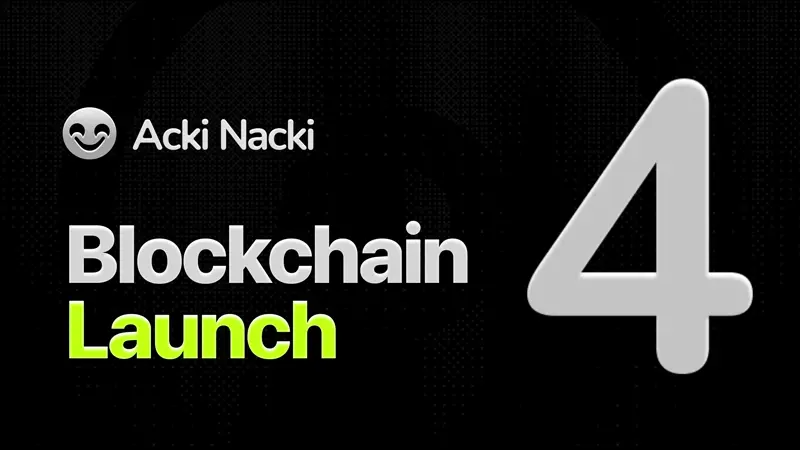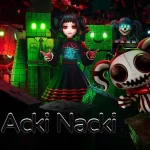At the heart of all this is Acki Nacki, an L1 blockchain built by GOSH, led by Mitja Goroshevsky, formerly CTO at TON Labs. Raised $6 million in a pre-launch node sale from major backers like Kingsway Capital, Blockchain.com, Hack VC, K5 Global, and Original Capital. No pre-mine, no team allocation, no token-gen event, it’s truly community-distributed.
It’s built on an asynchronous consensus model reaching finality in just two message rounds, claimed to be the lowest possible, enabling sub-second transactions. Think: scaling, speed, IoT, gaming, AI, all high-frequency, low-latency use cases. Sounds futuristic because it is.
Die Last & Popit Games: Mining by Playing
On-chain real-time strategy Die Last has already been integrated, but the real buzz is Popit Games, launching June 29 with in-game mining tied to gameplay.
Popit Games is a massively multiplayer roguelike deck-builder where players “create blocks” through card combos. Tokens, $NACKL, are mined based on performance using “Popits,” programmable cards that boost your score or sabotage rivals. It’s equal parts Poker, DnD, roguelike complexity, and a Balatro-style twist, layers of strategy, longevity, endlessly emergent.
June 29: Mining Goes Live
Starting June 29, anyone can join as a mobile blockchain verifier, contributing to consensus while playing. No pre-mined tokens, $NACKL is earned through gaming and network participation.
The token emission is governed by a 60-year mining schedule, deflationary, akin to Bitcoin models. The design is explicitly long-term: this isn’t a pump-and-dump, it’s built for persistent, sustainable community engagement.
Game Mechanics: Complexity Meets Continuity
Let’s unpack the game-mechanic layers:
-
Deck-building + roguelike loops
Players climb towers, face escalating challenges. Decks evolve with each run, like DnD campaigns on steroids. -
Programmable Popits
Each Popit is a card: chain combos to build “blocks” in-game, mirroring blockchain smart contracts. It empowers strategic depth beyond typical collectible card games. -
Mining tied to game success
Your in-game performance determines mining rewards. You’re not just playing, you’re securing the network. -
Infinite emergence
Like poker’s bluffing or DnD’s open-ended storytelling, Popit combos and tower runs unlock non-linear, unexpected strategies. -
Economy loop
Blocks produced in-game have on-chain effects, token minting, boosts, saboteurs, leaderboard status, tournament placements.
Popit Tournament & Esports Edge
GOSH is putting serious skin in the game. Earlier, Acki Nacki teased a $1 million Popit tournament with sizable prizes:
-
$27k top individual
-
$18k top team
-
$400k in node cores
-
100 million “boosts” for top 10k
-
Surprise rewards and early POP Coin decks
It’s esports meets mining meets long-form strategy. Winner-takes fame, fame takes nodes, nodes give long-term stake in blockchain. It’s smart layering: combine thrill, reward, and lasting network commitment.
Why It Matters: A Merge of Play and Protocol
This is not your average play-to-earn fad, it’s a functional integration of game mechanics, consensus, tokenomics, and decentralization.
-
User-driven validation: Gamers become validators without knowing the protocol, cryptography hidden behind turn-based tactics.
-
Rich token incentives: Those who play well are financially aligned with network health.
-
Long-lived engagement: Unlike short-term drops, this builds engagement over decades.
-
Game designers become protocol designers: Popits are code abstractions; they shape block creation and token release.
Risks and Open Questions
But every complex experiment needs scrutiny:
-
Security: Game code writing blocks, vulnerabilities? Token logic exploits? Audits will be essential.
-
Fairness: Are advanced players (and bots) going to dominate rewards? Will new users get crowded out?
-
Token value risk: $NACKL is earned by play, if token demand tanks, so does incentive.
-
Regulatory scrutiny: If playing = mining = earning cash, how do jurisdictions view it?
-
Complexity barrier: 60-year emission sounds gripping, but not everyone will care long-term.
The Broader Blockchain Context
Mining has evolved, from CPU → GPU → ASIC → staking. Acki Nacki introduces gameplay-as-mining, a novel mechanism pushing toward deeper user engagement.
It aligns with the broader Web3 trend: layered L1 ecosystems built around engagement loops, not just markets or marketplaces. It’s also forward-thinking: community-level consensus without overhead. If this works, it may become a blueprint for other chains adding gamified validation.
Prognosis & Timeline
| Timeline | What’s Likely |
|---|---|
| June–July 2025 | Popit game testers, early wins, security sweeps. First wave of gamers-miners. Community learning loops emerge. |
| Q3–Q4 2025 | Tournament buzz and streaming players. DAO formation around Popits and strategy. Early DeFi games piggybacking on mechanics. |
| 2026–27 | Third-party Popit decks, boosters, “meta” economy. Early fans building spin-off games on Acki Nacki. |
| 2028–30 | Cross-game Popits. Meta-gaming universes. Competing L1s mimic mechanisms. Regulators weigh in. |
| 2030+ | If sustainable, other L1s could integrate gamified mining. Acki will evolve multi-game, cross-chain ecosystems. |
My Take: Framed by an Introverted Dad-Futurist
It’s not just tokens, it’s systems that learn from play while play learns from systems. Acki Nacki is daring: it invites you to mine without knowing you’re mining, to validate blocks while building combos.
But risky? Absolutely. The valve between game abstraction and critical protocol must hold. Complexity is fun, until it’s fragile. This still needs airtight audits, fairness pacing models, and adaptable tokenomics if $NACKL overshoots or underperforms.
Yet if they nail the design, this could redefine how L1s onboard average users. Prompted by play, not wallets. Fundamental consensus by curious, engaged participants, not just whales or bots.
Remember: kids learning Popit combos might not learn Solidity or Rust that day, but they will learn conting, arithmics, they will develop mental atithmetic, logic, resource management, strategy, risk/reward, and system thinking. They may be tomorrow’s game devs, chain builders, or economists, all through play.
DYOR, yes, this isn’t hype. But Acki Nacki is applying game as infrastructure, not just incentive layer. That’s fresh. That’s bold. And it starts this June 29.




